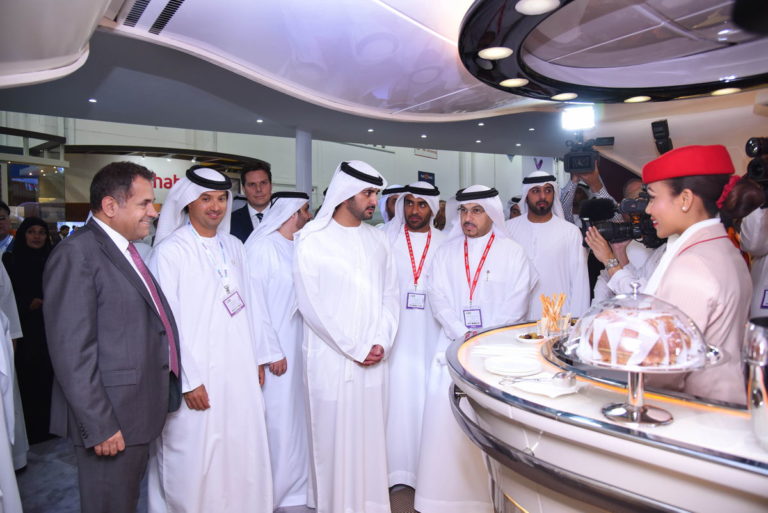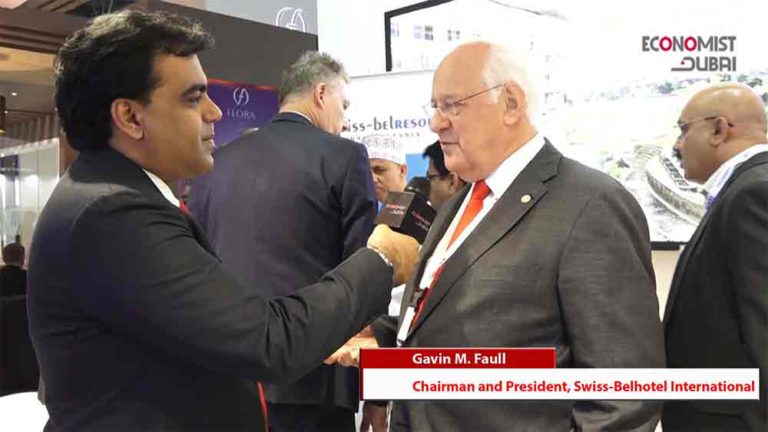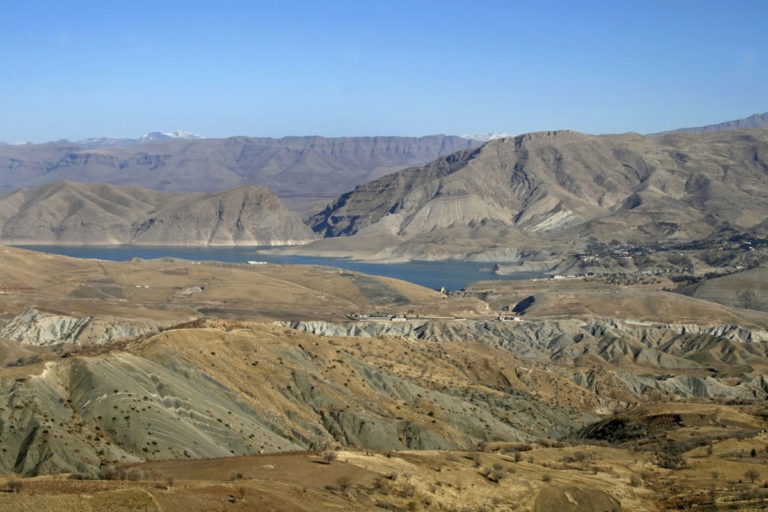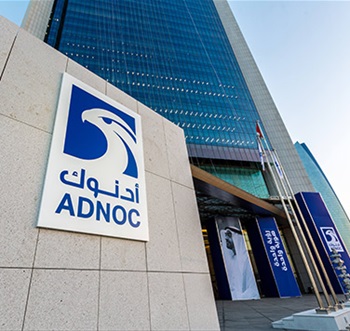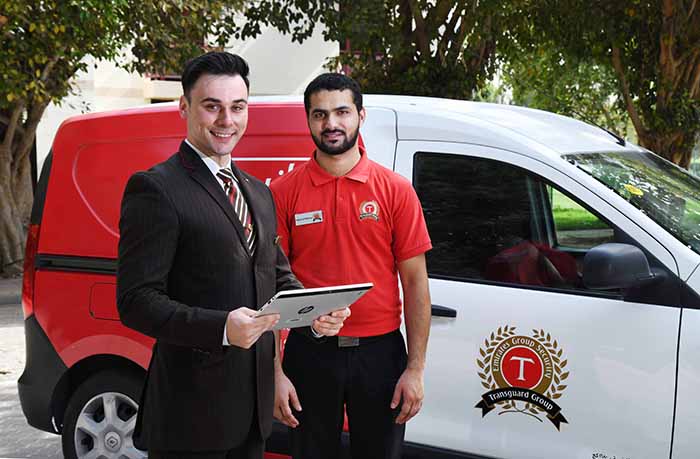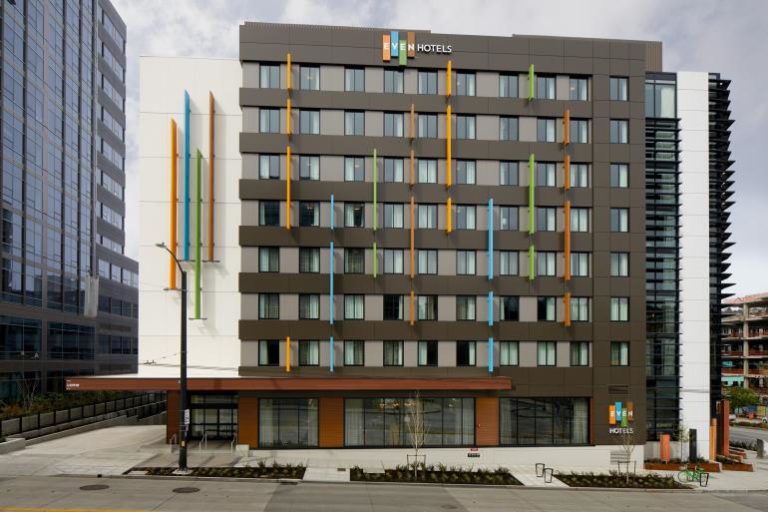Emirates’ stand was buzzing at this year’s ATM, with over 18,000 visitors making their way to the stand to experience the airline’s signature products and services. Visitors were also able to experience the new Boeing 777-300ER First Class Private Suite for the first time at ATM.
In addition, the Emirates stand showcased the airline’s recently launched products and service enhancements including latest Boeing 777 Business Class seat, the A380 OnBoard lounge, along with other iconic products such as the First Class Shower Spa and its generously-pitched Economy Class seats. UAE royal dignitaries and VIP guests visited the Emirates stand including His Highness Sheikh Maktoum bin Mohammed bin Rashid Al Maktoum, Deputy Ruler of Dubai; His Highness Sheikh Mohammed bin Hamad bin Mohammed Al Sharqi, Crown Prince of Fujairah; His Highness Sheikh Rashid bin Humaid Al Nuaimi, Chairman of Ajman Municipality and Planning Department; Major General Mohammed Ahmed Al Marri, Director General of the General Directorate of Residency and Foreigners Affairs in Dubai; and Hon. Cecilia Abena Dapaah, Ghanaian Minister of Aviation. Click here to watch Emirates’ highlights at this year’s edition of ATM. Over 125 meetings took place with industry trade partners and suppliers. Emirates also signed four agreements and memorandums of understanding with strategic partners to develop and enhance tourism traffic to destinations in its route network as well as its home of Dubai. ATM ran from 22-25 April and is the region’s largest travel trade exhibition.Deutsche Bank reports net income of 120 million euros for the first quarter of 2018
Next Mobile Economy Makes Its Debut at TED2018
An Open Vision: Experience New Mobile Economy at Social Space



Open Yet Secure
In the Next Mobile Economy, businesses will see an unprecedented increase in the speed and volume of data transactions. While this will enable more seamless operations, it also leaves companies at risk of security breaches and leaks.Open Yet Controlled
Prevention starts with finding mobile solutions that are open yet controlled and secure. These systems will allow IT managers to update and configure mobile devices remotely, while ensuring sensitive data is protected from potential cyberattacks.Open Customization
While delivering bespoke services is widely recognized as a key to success, few companies consider customizing their internal and B2B technologies as equally important. But relying on off-the-shelf software and systems will be insufficient in the Next Mobile Economy, as businesses which implement tailored solutions from top to bottom will have a head start.Open Collaboration
To develop customized mobile solutions and future-ready systems, companies need to establish open collaboration with their technology partners. The principle of open collaboration also has to extend to the technological tools in future workplaces. Equipping workers with mobile devices which encourage collaboration will be vital in creating greater flexibility and enhancing efficiency.Beyond a Slogan: New Mobile Economy in Action
The ideas and values of the Next Mobile Economy may seem far-fetched for some. But a closer look at the burgeoning mobile ecosystems at leading companies and organizations shows that the paradigm shift is already happening, generating transformative results. One such example is the Mobile Policing Program launched by the Surrey & Sussex Police Force in the UK. This police force worked closely with Samsung as its mobile partner to tailor, integrate and roll out secure mobile devices for police officers, which in turn are a vital means of collaborating in-field. Through these devices, the force reports improved sharing of vital information between county control rooms and officers on duty, emphasizing the future benefits such a collaborative approach could provide UK-wide policing. “Our mobile program has allowed greater co-operation between forces and means we can utilize our officers more effectively,” Shane Baker, Chief Inspector and head of digital transformation for Surrey & Sussex Police explains. “We see mobile as the tool to further unify and collaborate on the front line, bringing police forces together to ensure the public’s safety and experience of the police is joined up across the UK.” Both now and in the future, the control of certain enterprise mobile devices will be paramount to public safety. “Control of our mobile devices is absolutely important for us, given the nature of what we do,” states Baker. “We have had devices lost in the field and through using EMM systems such as Samsung Knox, we have been able to remotely wipe devices to ensure information and data isn’t released to the public.” For Chief Inspector Baker and his police colleagues, the additional layer of control provided by Samsung Knox has instilled greater confidence to use mobile devices in the field, enabling police officers to make more informed decisions at critical moments, with the knowledge that their devices are protected should they be damaged, lost or stolen.A Mobile Future: Solving Challenges and Creating Opportunities
While the foundations of the Next Mobile Economy are firmly in place, there are still more questions than answers on where the latest phase of digital revolution could take us. Only a multi-disciplinary global dialogue can help us maximize the full potential of this transformation. At TED2018, Samsung began laying the groundwork for such a platform. Gathering dozens of leading figures in key global industries, we led a three-day workshop to explore the use of mobile technology to solve problems and create opportunities. Through hours of engaging dialogue, the workshop generated fascinating insights on the future of New Mobile Economy in a wide-range of fields. Participants from the healthcare sector, for example, saw the potential of cloud technology to improve the accuracy and speed of gathering patients’ medical history. Artificial intelligence, meanwhile, could be used to analyze and improve urban traffic management. At the same time, the workshop served as a timely reminder that the Next Mobile Economy is still very much a work in progress. Debates raged on over potential technical and ethical problems that could arise from greater reliance on mobile technology. Control over information accuracy, the global digital divide and sources of funding for mobile infrastructure were among a long list of issues tackled during discussions. All technological revolutions are a product of collective actions, and the success of the New Mobile Economy will be no different. The conversations at Samsung’s Social Space and workshops are only the beginning of realizing a mobile future. To learn more about the Next Mobile Economy, please visit this link.‘Colours of My Life’ by Sarah bin Hendi at FN Designs
Emirati Artist Sarah bin Hendi’s fascinating painting exhibition ‘Colours of My Life’ at FN Designs promises to take viewers on a walk around a garden full of flowers. Opening for public on 2nd May 2018, the two-day exhibition is the young artist’s first solo show in Dubai and absolutely spectacular in every aspect. Featuring 23 paintings themed on ‘Modern Abstraction combined with Pop Art’, the collection is a kaleidoscope of colours.
Commenting on the intoxicating mix of colours, Sarah, said: “In my exhibition I want to show the viewers how color can affect their mind and soul, so they would live and feel a different and unique experience when they see my paintings. The purpose is to activate and motivate their imagination while examining each painting. More specifically, I want them to feel how each different combination of colors and brush strokes can attract their attention and make them feel the colors rather than just see them. I believe that colors have a tremendous effect on our lives.”
Sarah’s works are a psychedelic mix of different shapes and sizes. Elaborating on her style she said, “I hope I can introduce a new method on how to not just see artworks but feel the energy instead. In my paintings I always put and place the different shapes in a certain way, sometimes they’re connected or aligned and at other times they’re just flowing freely in the painting interacting with my color mixtures and brush strokes.”
Sensorially rich and immersive, each painting in Sarah’s collection has a story to tell. She stressed, ” the different organic shapes and flowers in my paintings have their own meanings and stories in my works, but in my exhibition, I want the visitors and viewers to make their own stories and interpretations based on what they see and feel, so everyone would interact differently with each painting of mine.
There is a lot to see and buy at the exhibition. Despite a common theme, each painting is unique with a drastic difference in scale of density. While some are simple others are complicated constructs of colour and pattern. Flowers are the centerpiece in many. Talking about the inspiration behind her beautiful works, Sahar revealed, “I got my inspiration from the different experiences I went through in my life, and the interactions I had with some people who touched my heart and soul in a very deep way emotionally and artistically. So, I would say my art is the result of these emotional experiences combined with my imagination and personal interpretation of these interactions. Colors, flowers and a variety of organic shapes are main elements in my paintings. They symbolize various meanings and feelings to me. Flowers are the most dominant elements in my artworks, because I consider them as the strongest symbols of emotions and I always associate them with people.”
Sarah is a Bachelor of Fine Arts from The American University in Dubai. In 2005 Sarah won a competition for Horse Design (Sheikh Mohammad’s Sponsorship of Dubai’s Celebration of the Arabian Horse). In the same year she also participated in a Post-It Note competition ‘3M Post-It Competition’ whereby her work was selected for an exhibition in Burjuman.
Gallery Location: FN Designs, Alserkal Avenue, Unit #26, Al Quoz 1, Street 8, Dubai, UAE FN Designs Timings: 10 am to 6pm from Sunday to Thursday
For media contact: Hina Bakht Managing Director EVOPS Marketing & PR Mob: 00971 50 6975146 Tel: 00971 4 566 7355 Hina.bakht@evops-pr.com www.evops-pr.com
flydubai to operate to five points in Iraq with the restart of flights to Sulaimaniyah
flydubai, the Dubai-based airline, announced today that flights to Sulaimaniyah will resume from 10 May 2018. The carrier now operates to five points in Iraq including Baghdad, Basra, Erbil and Najaf. The decision to relaunch the flights was taken following the Iraqi authorities’ announcement that that the airport reopened in March 2018.
Stay composed: here’s a quick rundown of the new Gmail
Do more without leaving your inbox
Gmail’s new look helps you get more done. Click on attachments—like photos—without opening or scrolling through large conversations, use the new snooze button to put off emails that you just can’t get to right now or easily access other apps you use often, like Google Calendar, Tasks (now available on Android and iOS) and Keep.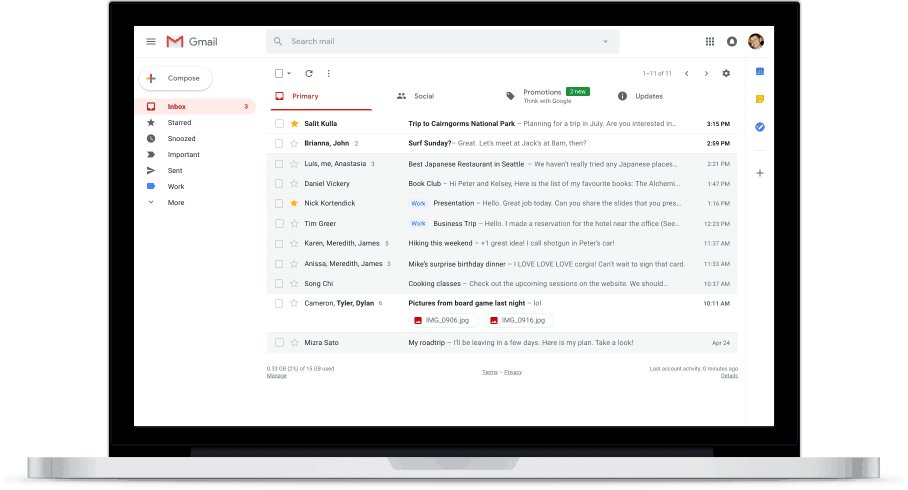
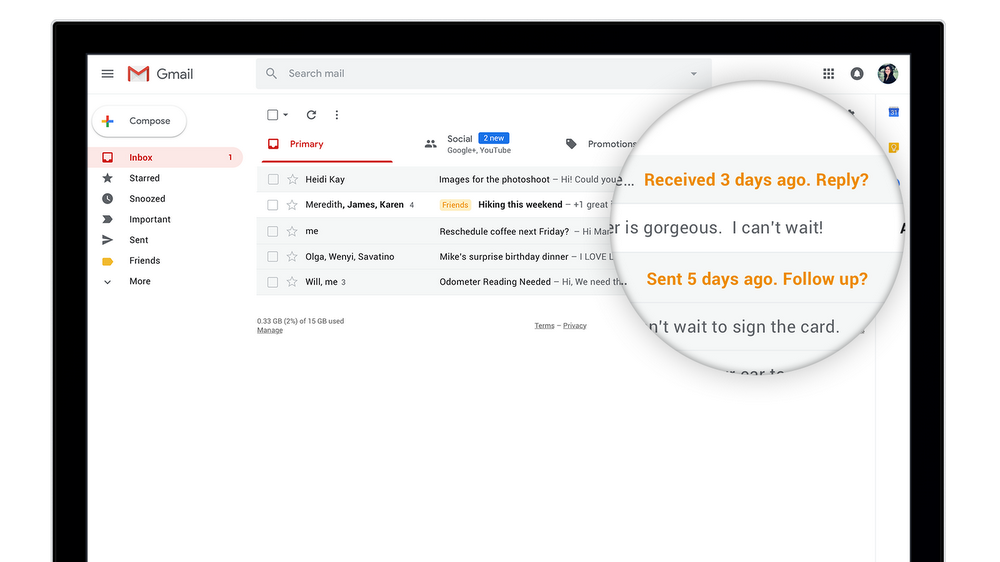
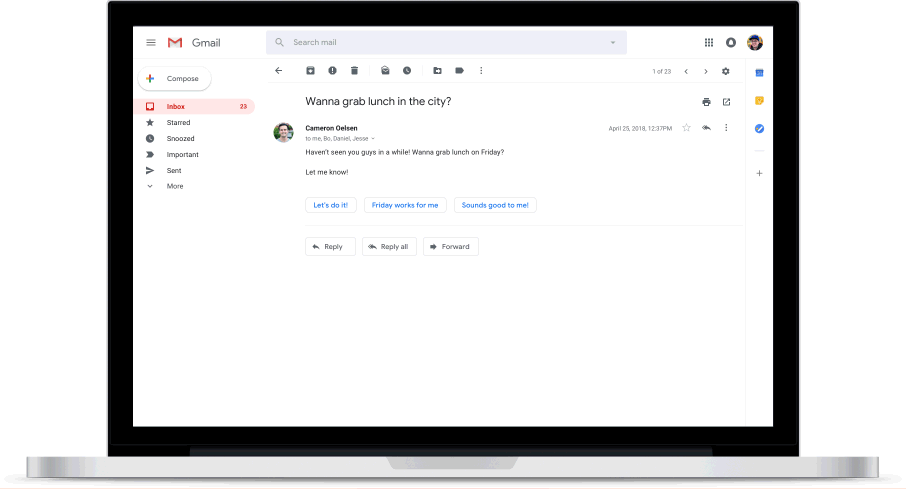

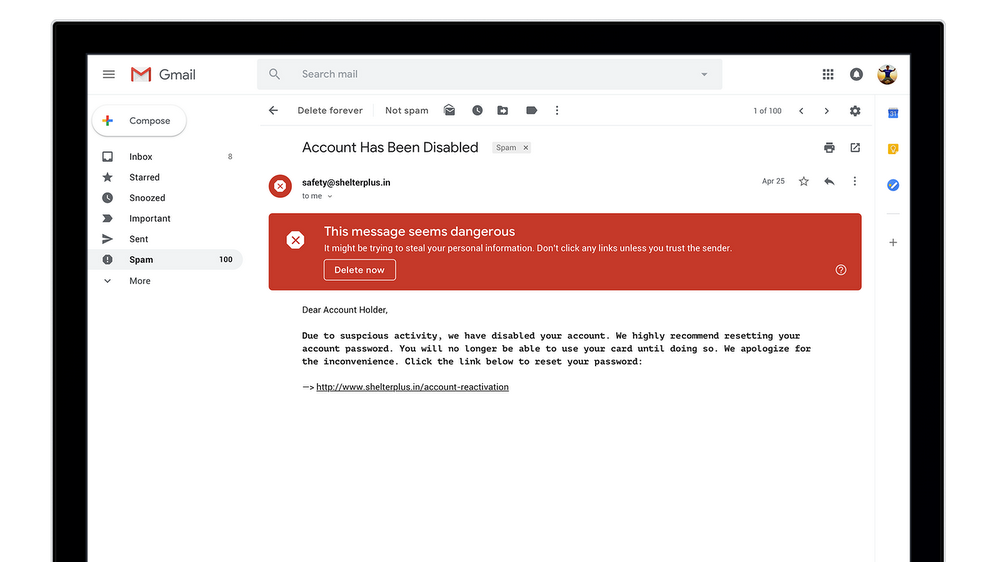
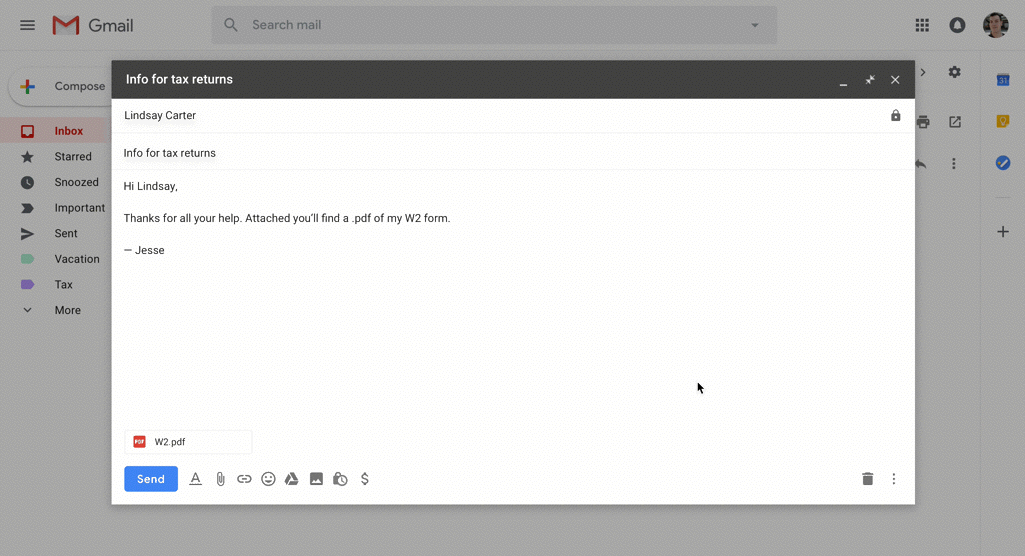
Get started
You can start using these new updates in Gmail on the web today, with some features appearing within the coming weeks. Go to Settings (the cog wheel in the top right corner of your inbox) and select “Try the new Gmail.” If you want to switch back later down the road, you can go to the same place and select “Go back to classic Gmail.”If you’re interested in learning more about how you can use Gmail in the workplace, check out our G Suite post which has more detail on all of the ways Gmail can help you stay productive.ADNOC to Engage in Non-Speculative Trading to Optimize Crude and Product Flows Across Value Chain and Support Downstream International Growth
Emirates introduces Home Check-in in Dubai
Emirates has introduced Home Check-in, a new service which allows customers to check in for their flights from anywhere in Dubai. The service is available for customers across all classes travelling on Emirates flights.
The new service enables Emirates passengers to complete the security check and check-in from the comfort of their home, hotel or office and have their luggage transported to the airport prior to their flight. An Emirates check-in agent will arrive at the preferred location to weigh and tag the bags as well as check-in the customers and issue boarding passes. Customers can then make their own way to the airport and head directly to immigration, bypassing the check-in desks at the airport. The service is available for AED 350 per trip for up to 7 pieces of luggage. AED 35 will be charged for each additional piece of luggage. Customers can book the service on emirates.com up to 12 hours before flight departure time. This latest initiative is part of the Emirates’ ongoing commitment to provide world class products and services for a more convenient travel experience. Emirates has been running trials for its Home Check-in service since October to ensure that the customer experience and security checks are faultless. The service seals each bag and stores them in a separate hold in the van. Emirates Home Check-in will be operated with a new fleet of vans. The new Home Check-in offering complements other luggage handling services already available for Emirates flights in Dubai. For a seamless travel experience, customers can pay for a concierge service to handle their luggage at the airport, enjoy preferred rates for pre-paid excess baggage, and bag wraps to protect their luggage. For passengers arriving in Dubai, there is a luggage storage facility for those who wish to leave their bags and explore the city. Emirates also offers a Home Delivery service where luggage is retrieved, cleared at customs and delivered to the customers for a hassle free travel experience. More information on these services can be found here.NOBLE and IHG® Announce the Opening of the Dual-Branded EVEN® Hotel and Staybridge Suites® Hotel South Lake Union in Downtown Seattle
Elie Maalouf, CEO of InterContinental Hotels Group, The Americas said: “We are thrilled about growing both the EVEN Hotels and Staybridge Suites brands on the West Coast in partnership with a best-in-class owner like Noble. This project demonstrates the strong momentum for two of IHG’s growing brands and shows our commitment to expanding to high-profile markets.”
Mit Shah, CEO of Noble Investment Group said: “These first-class hotels are the perfect fit for the dynamic and rapidly expanding South Lake Union market that is an international hub and home to a diverse mix of tech, medical and corporate businesses.”
For more information about EVEN Hotels or to book an upcoming stay, please visit EVENHotels.com. For more information about Staybridge Suites or to book an upcoming stay, please visit Staybridge.com. Please find additional images of the EVEN Hotel and Staybridge Suites Hotel South Lake Union in this link. Ends
